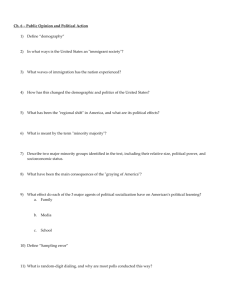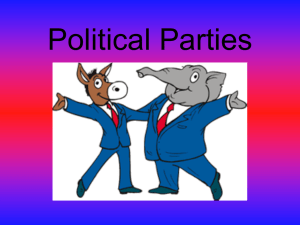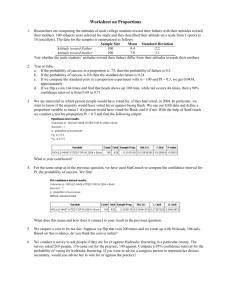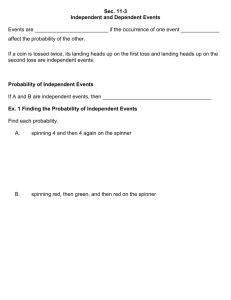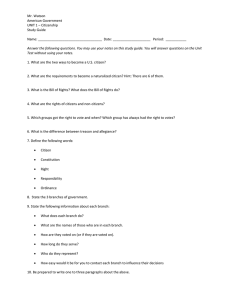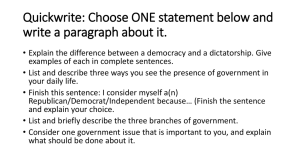Math 141 Exam 3 Review 1. P(E)=0.5, P(F)=0.6 P(E a) P(
advertisement
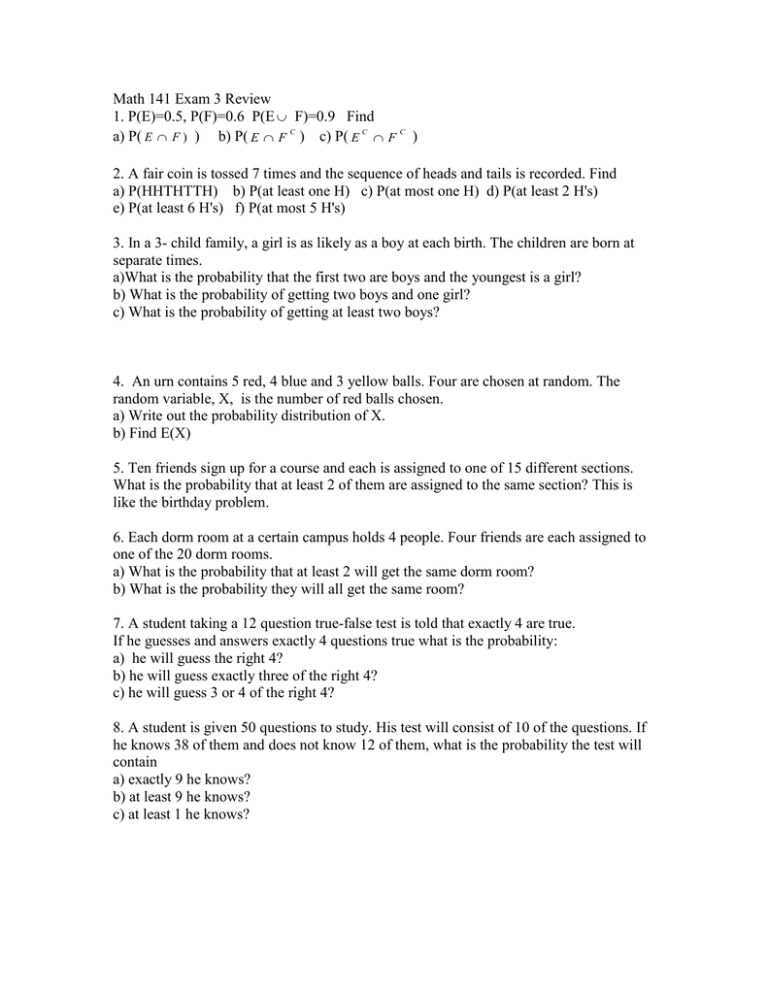
Math 141 Exam 3 Review 1. P(E)=0.5, P(F)=0.6 P(E F)=0.9 Find a) P( E F ) ) b) P( E F C ) c) P( E C F C ) 2. A fair coin is tossed 7 times and the sequence of heads and tails is recorded. Find a) P(HHTHTTH) b) P(at least one H) c) P(at most one H) d) P(at least 2 H's) e) P(at least 6 H's) f) P(at most 5 H's) 3. In a 3- child family, a girl is as likely as a boy at each birth. The children are born at separate times. a)What is the probability that the first two are boys and the youngest is a girl? b) What is the probability of getting two boys and one girl? c) What is the probability of getting at least two boys? 4. An urn contains 5 red, 4 blue and 3 yellow balls. Four are chosen at random. The random variable, X, is the number of red balls chosen. a) Write out the probability distribution of X. b) Find E(X) 5. Ten friends sign up for a course and each is assigned to one of 15 different sections. What is the probability that at least 2 of them are assigned to the same section? This is like the birthday problem. 6. Each dorm room at a certain campus holds 4 people. Four friends are each assigned to one of the 20 dorm rooms. a) What is the probability that at least 2 will get the same dorm room? b) What is the probability they will all get the same room? 7. A student taking a 12 question true-false test is told that exactly 4 are true. If he guesses and answers exactly 4 questions true what is the probability: a) he will guess the right 4? b) he will guess exactly three of the right 4? c) he will guess 3 or 4 of the right 4? 8. A student is given 50 questions to study. His test will consist of 10 of the questions. If he knows 38 of them and does not know 12 of them, what is the probability the test will contain a) exactly 9 he knows? b) at least 9 he knows? c) at least 1 he knows? 9.. A person tosses a fair coin 4 times. Find the probability that the first toss was heads given there were exactly two heads. b) Are the events “the first toss is heads” and “there are exactly two heads” independent? c) Repeat a) and b) with the coin tossed 5 times. 10. P(A)=0.7 , P(B)=0.6 and P(A C B)=0.2 Are A and B independent. Show why or why not. 11. In a town in the 1920’s , 70% of the voters were farmers, 20% were merchants and 10% had some other occupation. Assume no one had two occupations. In the mayoral election, 60% of the farmers voted for the democrat, 30% of the merchants voted for the democrat and 70% of the others voted for the democrat. The rest voted republican. Find the probability that a) a farmer voted democrat. b) someone who voted democrat was a farmer. c) someone voted democrat and was a farmer. 12. A lab test tests for use of a certain drug. It is estimated that 8% of people taking the test uses the drug. The test is positive in 4% of those who do not use the drug and is positive in 93% of those who do. a) Find the probability that someone who gets a positive test actually uses the drug. b) Find the probability someone who gets two positive consecutive tests uses the drug. 13. Some mice were tested to see if listening to music improved their intelligence. Seventy five mice listened to classical music daily and 75 listened to no music. Eighty of the mice were able to finish a certain maze in less than 5 minutes. Sixty of these had listened to classical music. Are listening to classical music and finishing the maze in less than 5 minutes independent? Use probabilities to support your answer. As a note of interest, some other mice listened to heavy metal music daily. They were bumping into walls and couldn’t finish the maze in 10 minutes. 14. In a voter survey 1500 respondents were asked if they had an immediate family member in the military and if they were voting for the democrat or the republican. The results were that 500 had a family member in the military and 140 of these were voting for the democrat. Overall 660 voted for the democrat and 840 voted republican. Let M be the set of all those who had a family member in the military, R those who voted republican, and D those who voted democrat. Find the probability that a) someone who had a military relative voted republican. b) someone who voted democrat does not have a military relative. c) a voter has no military relative and is voting republican. d) Are M and R independent? e) Are M and D independent? 15. Three workers work independently to solve a problem. The events that each solves it are independent. The probabilities that worker 1, 2 or 3 will solve it are 0.7, 0.5, and 0.8 respectively. Find the probability that a) at least one will solve it. b) at least one will not solve it. c) exactly one will solve it. 16. A coin is weighted so that P(H)=1/3. The coin is tossed 5 times. a) Find P(HHHTT). b) Find P(exactly 3 heads). c) If X is the number of heads in 5 tosses, find E(X) and the standard deviation of X. 17. Stocks I, II, and III have returns of 10%, 12% and 15% respectively. A person invests 20% of his money in stock I, 30% in stock II and 50% in stock III. Find his expected return. 18.. Find the mean, median, mode, standard deviation and variance for: a) the quiz scores which are: quiz score 0 # students 16 1 21 b) the price per share of a stock: stock price in $ # days c) the price per share of a stock: stock price in $ # days Why is the standard deviation in c higher than in b? 2 14 3 15 4 24 20 5 20 10 21 3 21 6 22 14 22 1 5 10 23 24 4 4 23 24 3 10 19.. A student has 36 credit hours and a gpa of 3.2. He takes four 3-credit courses and receives two A’s, one B and one C. Find his new gpa. 20. Classify each random variable as finite, infinite discrete or continuous. I A person is given 30 minutes to complete a test. a) X is the time he spends taking the test. b) Y is the number of times a person takes the test until he passes. c) N is the number of correct answers a person gets. II A die is tossed. a) X is the distance the die travels upward. b)Y is the top number on the die. c) N is the number of times the die is tossed until a 6 appears. 21.. Three balls are drawn all at once without replacement from a box containing 5 red and 7 blue balls. X is the number of red balls drawn. a) Write the probability distribution of X. b) Write the probability distribution of X given there is at least one red ball. 22.a) If the odds you will win a raffle are 5:20, what is the probability you will win? b) If the chance of rain is 30%, what are the odds it will not rain? 23.. Which of the following are binomial? If binomial give n and p. If not binomial say why not. a) A box contains 5 red, 6 blue and 4 yellow balls. A person draws one ball and notes whether or not the ball is red. Then the ball is returned to the box. This is repeated 10 times. X is the number of red balls drawn. b) A person draws 1 card from a deck and notes the suit. The card is not returned to the deck. This is repeated 15 times. X is the number of hearts. c) A certain gene occurs in 7% of the general population. Seven people from one family and 6 people from another family are selected. X is the number of people who have the gene. d) Same as c) but 50 people are selected at random. 24. For 23d, find P(2 X 4).
